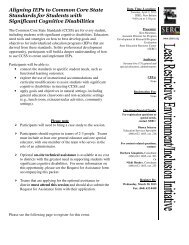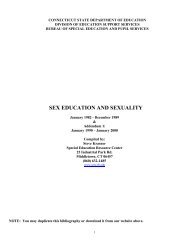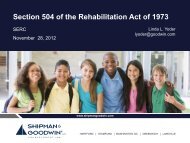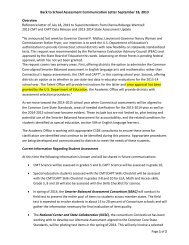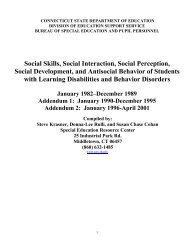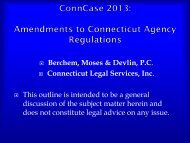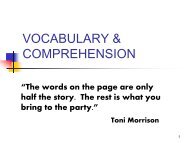Differentiated and Individualized Instruction - The State Education ...
Differentiated and Individualized Instruction - The State Education ...
Differentiated and Individualized Instruction - The State Education ...
Create successful ePaper yourself
Turn your PDF publications into a flip-book with our unique Google optimized e-Paper software.
CONNECTICUT STATE DEPARTMENT OF EDUCATIONDIVISION OF EDUCATIONAL PROGRAMS AND SERVICESBUREAU OF SPECIAL EDUCATION<strong>Differentiated</strong> <strong>and</strong> <strong>Individualized</strong><strong>Instruction</strong>1999-2003Compiled by:<strong>The</strong> SERC Library25 Industrial Park Rd.Middletown, CT 064571-860-632-1485www.ctserc.orgPLEASE NOTE:As of July 1, 2002 the SERC Library bibliographies are typed in accordance withthe 5 th edition Publication Manual of the American Psychological Association with theonly exception being that they are not double-spaced in order to save paper.Resources included in this bibliography do not indicate approval or endorsementby SERC or the CT <strong>State</strong> Department of <strong>Education</strong>. <strong>The</strong> listings are provided solely as aresource of general information.Please note citations with a W (Wilson’s <strong>Education</strong> Index), PB (EBSCOHost Psychology <strong>and</strong>Behavioral Sciences Collection), PD (EBSCOHost Professional Development Collection) <strong>and</strong> E (EBSCOHostERIC) after the page listings can be downloaded from the online databases available at the SERC Library.SL after the page listings indicates that the journal article is available in the SERC Library’s journalcollection.
Brooks, A., Vaughan, K., & Berninger, V. (1999). Tutorial interventions for writing disabilities: Comparisonof transcription <strong>and</strong> text generation processes. Learning Disability Quarterly, 22, 183-190 SL.Brown, W. H., Odom, S.L., Li, S., & Zercher, C. (1999). Ecobehavioral assessment in early childhoodprograms: A portrait of preschool inclusion. Journal of Special <strong>Education</strong>, 33, 138-153 SL E.Bursuck, W. D., Munk, D.D., Nelson, C., & Curran, M. (2002). Research on the prevention of readingproblems: Are kindergarten <strong>and</strong> first grade teachers listening? Preventing School Failure, 47,4-9 SL E.Bushman, J., Goodman, G., Brown-Welty, S., & Dorn, S. (2001). California testing: How principals choosepriorities. <strong>Education</strong>al Leadership, 59(1), 33-36 SL E.Buysse, V., Skinner, D., & Grant, S. (2001). Toward a definition of quality inclusion: Perspectives of parents<strong>and</strong> practitioners. Journal of Early Intervention, 24, 146-161 SL.Callahan, C. M. (1999). Classrooms for learners, not winners or losers. High School Magazine, 7(1),22-28 SL W.Callahan, C. M. (2001). Fourth down <strong>and</strong> inches. Journal of Secondary Gifted <strong>Education</strong>, 12, 148-156 SL E.Center, Y., Freeman, L., & Robertson, G. (2000). <strong>The</strong> relative effect of a code-oriented <strong>and</strong> a meaningorientedearly literacy program on regular <strong>and</strong> low progress Australian students in year 1 classroomswhich implement reading recovery. International Journal of Disability, Development <strong>and</strong> <strong>Education</strong>,48, 207-232 SL E.Coufal, K. L. (2002). Technology teaching or mediated learning, part II, 1990's: Literacy linkages <strong>and</strong>intervention contexts. Topics in Language Disorders, 22(4), 29-55 SL PB.Dahl, K. L., Scharer, P.L., Lawson, L.L. (1999). Phonics instruction <strong>and</strong> student achievement in wholelanguage first-grade classrooms. Reading Research Quarterly, 34, 312-341 SL.D'Amico, J. J. (2001). A closer look at the minority achievement gap. ERS Spectrum, 19(2), 4-10 SL.Daniels, D. H., Perry, K.E. (2003). "Learner-centered" according to children. <strong>The</strong>ory into Practice, 42, 102-108 SL W.Davalos, R., & Griffin, G. (1999). <strong>The</strong> impact of teachers' individualized practices on gifted students in rural,heterogeneous classrooms. Roeper Review, 21, 308-314 SL E.Davalos, R. A., & Griffin, G. (1999). Empowering teachers <strong>and</strong> students to change through shared language.<strong>Education</strong> (Chula Vista, CA), 119, 542-550 W.Decker, G. S. (2003). Creating a framework to make data-driven instruction a reality. Multimedia Schools,10(2), 22-25 W.Delisle, J. R. (1999). For gifted students, full inclusion is a partial solution. <strong>Education</strong>al Leadership, 57(3),80-83 SL E.3
Donaldson, G. A., Jr. (2000). A promising future for every student: Maine invests in secondary reform.NASSP Bulletin, 84(615), 100-107 SL.Donovan, C. A., Rovegno, I., & Dolly, J.P. (2000). Teaching development <strong>and</strong> diversity in field-basedmethods courses. Action in Teacher <strong>Education</strong>, 22(3), 37-46 SL W.Dowling-Sendor, B. (2000). How far should an IEP go? American School Board Journal, 187(12), 12-17 SL.Doyle, M. B. (2000). Transition plans for students with disabilities. <strong>Education</strong>al Leadership, 58(1), 46-48SL W.DuBosq, J. E. (2002). Take it to the next level individualized instruction in technology education. TechDirections, 61(7), 29-32 SL PD.Dunn, M. A. (2000). Staying the course of open education. <strong>Education</strong>al Leadership, 57(7), 20-24 SL E.Duwell, M. J., & Bennett, E. (2000). Weaving technology into gifted curriculum. Underst<strong>and</strong>ing Our Gifted,12(3), 9-13 SL.Easton, L. B. (2002). Lessons from learners. <strong>Education</strong>al Leadership, 60(1), 64-68 SL E.Edmiaston, R. K., & Fitzgerald, L.M. (2000). How Reggio Emilia encourages inclusion. <strong>Education</strong>alLeadership, 58(1), 66-69 SL W.Erb, T. (2002). Diverse students learning to new st<strong>and</strong>ards. <strong>The</strong> editor reflects. Middle School Journal, 33(3),4 SL.Evers, W. J. G., Brouwers, A., & Tomic, W. (2002). Burnout <strong>and</strong> self-efficacy: A study on teachers' beliefswhen implementing an innovative educational system in the Netherl<strong>and</strong>s. British Journal of<strong>Education</strong>al Psychology, 72, 227-244 PB.Fahey, J. A. (2000). Who wants to differentiate instruction? We did--. <strong>Education</strong>al Leadership, 58(1), 70-72SL W.Fischer, D. (2000). Curriculum & instruction for all abilities <strong>and</strong> intelligences. High School Magazine, 7(7),21-25, 52 SL.Fischer, K. W., & Rose L.T. (2001). Webs of skill: How students learn. <strong>Education</strong>al Leadership, 59(3), 6-12SL W.Freschi, D. F. (1999). Guidelines for working with one-to-one aides. Teaching Exceptional Children, 31(4),42-45 SL.Fuchs, L. S., & Fuchs, D. (2001). Principles for sustaining research-based practice in the schools: A casestudy. Focus on Exceptional Children, 33(6), 1-14 SL W.Ganley, K. (200o). Quality goals, objectives, benchmarks. ASHA Leader, 5(18), 4-6 PD.Garcia, J. C. (2001). An instrument to help teachers assess learners' attitudes towards multimedia instruction.<strong>Education</strong>, 122(1), 94-102 PD.4
Gelzheiser, L. M., Griesemer, B.A., & Pruzek, R.M. (2000). How are developmentally appropriate ortraditional teaching practices related to the mathematics achievement of general <strong>and</strong> special educationstudents? Early <strong>Education</strong> <strong>and</strong> Development, 11, 217-238 SL.Gentry, M., & Owen, S.V. (1999). An investigation of the effects of total school flexible cluster grouping onidentification, achievement, <strong>and</strong> classroom practices. Gifted Child Quarterly, 43, 224-243 SL.Geocaris, C., & Ross, M. (1999). A test worth taking. <strong>Education</strong>al Leadership, 57(1), 29-33 SL E.George, P. S., & McEwin, C.K. (1999). High schools for a new century: Why is the high school changing?NASSP Bulletin, 83(606), 10-24 SL.George, P. S., Weast, J.D., & Jones, L. (2000). Revitalizing middle schools: <strong>The</strong> Guilford County process.Middle School Journal, 31(3), 3-11 SL.Germain, R. (2001). Access to numeracy: A case study. British Journal of Special <strong>Education</strong>, 28, 182-186SL E.Goldberg, M. F. (2001). Balanced optimism: An interview with Linda Darling-Hammond. Phi Delta Kappan,82, 687-690 SL E.Goodwin, A. L. (2002). Teacher preparation <strong>and</strong> the education of immigrant children. <strong>Education</strong> <strong>and</strong> UrbanSociety, 34, 156-172 SL.Gould, H. C. (2000). Can we meet st<strong>and</strong>ards <strong>and</strong> encourage teachers to differentiate for the highly able?NASSP Bulletin, 84(615), 74-78 SL W.Grant, J. (2003). Differentiating for diversity. Principal (Reston, VA), 82(3), 48-51 W.Gunter, P. L., Denny, R.K., & Venn, M.L. (2000). Modification of instructional materials <strong>and</strong> procedures forcurricular success of students with emotional <strong>and</strong> behavioral disorders. Preventing School Failure, 44,116-121 SL W.Halbach, A., Ehrle, K, Zahorik, J., & Molnar, A. (2001). Class size reduction: From promise to practice.<strong>Education</strong>al Leadership, 58(6), 32-35 SL E.Hausman, C., & Brown, P.M. (2002). Curricular <strong>and</strong> instructional differentiation in magnet schools: Marketdriven or institutionally entrenched? Journal of Curriculum <strong>and</strong> Supervision, 17, 256-276 SL W.Herr, P. (2000). Reaching every student: <strong>The</strong> Loudon County story. Multimedia Schools, 7(1), 38-41 W.Heuser, D. (2000). Reworking the workshop for math <strong>and</strong> science. <strong>Education</strong>al Leadership, 58(1), 34-37SL W.Hiebert, E. H., & Pearson, P.D. (2000). Building on the past, bridging to the future: A research agenda for theCenter for the Improvement of Early Reading Achievement. <strong>The</strong> Journal of <strong>Education</strong>al Research(Washington, D.C.), 93(3), 133-144 W.Hollifield, T. (2000). Reflections from an inclusion teacher. Primary Voices K-6, 9(1), 24-26 SL.5
Holloway, J. H. (2000). Preparing teachers for differentiated instruction. <strong>Education</strong>al Leadership, 58(1), 82-83SL W.Honigsfeld, A. (1999). Global warming: It's not cool! Science <strong>and</strong> Children, 36(6), 46-51 SL.Hooper, D. W. (2002). Improving instruction as a team. School Administrator, 59(4), 42 W.Houtveen, T., & Van de Grift, W. (2001). Inclusion <strong>and</strong> adaptive instruction in elementary education. Journalof <strong>Education</strong> for Students Placed at Risk (JESPAR), 6, 389-409 SL E.Hughes, L. (1999b). Action research <strong>and</strong> practical inquiry: How can I meet the needs of the high-abilitystudent within my regular education classroom? Journal for the <strong>Education</strong> of the Gifted, 22, 282-297SL W.Hulse, J. (2002). Supporting advanced learners. Principal Leadership (Middle School Ed.), 2(8), 32-35 W.Hurth, J., Shaw, E., Izeman, S.G., Whaley, K., & Rogers, S.J. (1999). Areas of agreement about effectivepractices among programs serving young children with autism spectrum disorders. Infants <strong>and</strong> YoungChildren, 12(2), 17-28 SL E.Ivey, G. (2000). Redesigning reading instruction. <strong>Education</strong>al Leadership, 58(1), 42-45 SL W.Javid, M. A. (2000). A suggested model for a working cyberschool. <strong>Education</strong>al Technology, 40(1), 61-63 SL.Jenkins, J. M., & Keefe, J.W. (2001). Strategies for personalizing instruction: A typology of improvingteaching <strong>and</strong> learning. NASSP Bulletin, 85, 72-82 SL W.Jenkins, J. M., & Keefe, J.W. (2002a). Personalized instruction. Phi Delta Kappan, 83, 440-449 SL.Jenkins, J. M., & Keefe, J.W. (2002b). Two schools: Two approaches to personalized learning. Phi DeltaKappan, 83, 449-457 SL PD.Johnson, A. P. (2000). How to use thinking skills to differentiate curricula for gifted <strong>and</strong> highly creativestudents. Gifted Child Today, 24(4), 58-63 SL W.Johnson, G. M. (1999). Inclusive education: Fundamental instructional strategies <strong>and</strong> considerations.Preventing School Failure, 43, 72-78 SL E.Joonkoo, Y., & Shapiro, D. (2000). Reaching IEP goals in the general physical education class. Journal ofPhysical <strong>Education</strong>, Recreation & Dance (JOPERD), 71(8), 33-38 SL.Juel, C., & Minden-Cupp, C. (2000). Learning to read words: Linguistic units <strong>and</strong> instructional strategies.Reading Research Quarterly, 35, 458-492 SL.Kaplan, S. N. (2002). Awakening <strong>and</strong> elaborating differentiation in social studies content <strong>and</strong> instruction.Gifted Child Today, 25(3), 18-23 SL W.Kapusnick, R. A., & Hauslein, C.M. (2001). <strong>The</strong> 'silver cup' of differentiated instruction. Kappa Delta PiRecord, 37, 156-159 W.6
Karp, K. S., & Voltz, D.L. (2000). Weaving mathematical instructional strategies into inclusive settings.Intervention in School <strong>and</strong> Clinic, 35(206-215 SL E).Keefe, J. W., & Jenkins, J.M. (2002). Personalized instruction. Phi Delta Kappan, 83, 440-448 SL.Kern, L., Delaney, B., Clarke, S., Dunlap, G., & Childs, K. (2001). Improving the classroom behavior ofstudents with emotional <strong>and</strong> behavioral disorders using individualized curricular modifications.Journal of Emotional <strong>and</strong> Behavioral Disorders, 9, 239-247 SL E.Kleinert, H. L., Kennedy, S., & Kearns, J.F. (1999). <strong>The</strong> impact of alternate assessments: A statewide teachersurvey. Journal of Special <strong>Education</strong>, 33, 93-102 SL E.Kliewer, C., & L<strong>and</strong>is, D. (1999). Individualizing literacy instruction for young children with moderate tosevere disabilities. Exceptional Children, 66(1), 85-100 SL.Klonsky, S., & Klonsky, M. (1999). Countering anonymity through small schools. <strong>Education</strong>al Leadership,57(1), 38-41 SL E.Koeing, A. J., & Holbrook, M.C. (2000). Ensuring high-quality instruction for students in Braille literacyprograms. Journal of Visual Impairment & Blindness, 94, 677-694 SL E.Kroeger, S. D., & Leibold, C.K. (1999). Creating a sense of ownership in the IEP process. TeachingExceptional Children, 32(1), 4-10 SL PD.Kuntz, K. J., McLaughlin, T.F., & Howard, V.F. (2001). A comparison of cooperative learning <strong>and</strong> smallgroup individualized instruction for math in a self-contained classroom for elementary students withdisabilities. <strong>Education</strong>al Research Quarterly, 24(3), 41-57 PB.L<strong>and</strong>is, M. (2002). Language <strong>and</strong> literacy, digitally speaking. Topics in Language Disorders, 22(4), 55-69SL E.L<strong>and</strong>rum, M. S. (2001). An evaluation of the catalyst program: Consultation <strong>and</strong> collaboration in giftededucation. Gifted Child Quarterly, 45(139-151 SL).Larkin, M. J. (2001). Providing support for student independence through scaffolded instruction. TeachingExceptional Children, 34(1), 30-34 SL E.Leyser, Y. (2002). Choices of instructional practices <strong>and</strong> efficacy beliefs of Israeli general <strong>and</strong> specialeducators: A cross-cultural research initiative. Teacher <strong>Education</strong> <strong>and</strong> Special <strong>Education</strong>, 25,154-167 SL.Leyser, Y., & Tappendork, K. (2001). Are attitudes <strong>and</strong> practices reading mainstreaming changing? A case ofteachers in two rural school districts. <strong>Education</strong> (Chula Vista, CA), 121, 751-760 W.Liddle, K. (2000). Data-driven success: How one elementary school mined assessment data to improveinstruction. American School Board Journal, 187(3), 30-32 SL.Littky, D., & Allen, F. (1999). Whole-school personalization, one student at a time. <strong>Education</strong>al Leadership,57(1), 24-29 SL PD7
Lloyd, C., Wilton, K., & Townsend, M. (2000). Children at high-risk for mild intellectual disability in regularclassrooms: Six New Zeal<strong>and</strong> case studies. <strong>Education</strong> <strong>and</strong> Training in Mental Retardation <strong>and</strong>Developmental Disabilities, 35(1), 44-54 SL.Lou, Y., Abrami, P.C., & d'Apollonia, S. (2001). Small group <strong>and</strong> individual learning with technology: Ameta-analysis. Review of <strong>Education</strong>al Research, 71, 449-521 SL.Manthey, G. (2002). Differentiation of student practice no longer optional. Leadership, 31(5), 33 W.Marlowe, J. (2000). Learning alone. American School Board Journal, 187(12), 56-57, 62 SL.Massey, N. G., & Wheeler, J.J. (2000). Acquisition <strong>and</strong> generalization of activity schedules <strong>and</strong> their effectson task engagement in a young child with autism in an inclusive pre-school classroom. <strong>Education</strong> <strong>and</strong>Training in Mental Retardation <strong>and</strong> Developmental Disabilities, 35, 326-335 SL.Masterson, J. J., & Crede, L.A. (1999). Learning to spell: Implications for assessment <strong>and</strong> intervention.Language, Speech, <strong>and</strong> Hearing Services in Schools, 30, 243-254 SL E.Mawhinney, T. S. (2000). Finding the answer. Principal Leadership (High School Ed.), 1(4), 44-48 W.McAdamis, S. (2000). A district-wide plan for acceleration <strong>and</strong> enrichment: Rockwood School District,Eureka. Gifted Child Today, 23(3), 20-27 SL W.McAdamis, S. (2001). Individual paths. Journal of Staff Development, 22(2), 48-50 SL W.McCathren, R. B. (2000). Teacher-implemented prelinguistic communication intervention. Focus on Autism<strong>and</strong> Other Developmental Disabilities, 15(1), 21-29 SL E.McCullen, C. (2003). Celebrating differences. Principal Leadership (High School Ed.), 3(8), 34-36 W.Miracle, S. A., Collins, B.C., Schuster, J.W., & Grisham-Brown, J. (2001). Peer-versus teacher-deliveredinstruction: Effects on acquisition <strong>and</strong> maintenance. <strong>Education</strong> <strong>and</strong> Training in Mental Retardation<strong>and</strong> Developmental Disabilities, 36, 373-385 SL.Mobayed, K. L., Collins, B.C., Strangis, D.E., Schuster, J.W., & Hemmeter, M.L. (2000). Teaching parents toemploy m<strong>and</strong>-model procedures to teach their children requesting. Journal of Early Intervention, 23,165-179 SL.Moody, S. W., Vaughn, S., & Hughes, M.T. (2000). Reading instruction in the resource room: Set up forfailure. Exceptional Children, 66, 305-316 SL W.Moore, S. D., & Bintz, W.P. (2002). Teaching geometry <strong>and</strong> measurement through literature. MathematicsTeaching in the Middle School, 8(2), 78-84 SL W.Morrison, F. J., & Connor, C.M. (2002). Underst<strong>and</strong>ing schooling effects on early literacy: A workingresearch strategy. Journal of School Psychology, 40, 493-500 SL E.Nuckles, C. R. (2000). Student-centered teaching: Making it work. Adult Learning, 11(4), 5-7 PD.Olenchak, F. R. (2001). Lessons learned from gifted children about differentiation. <strong>The</strong> Teacher Educator,36(3), 185-198 W.8
O'Neil, J., & Tell, C. (1999). Why students lose when 'tougher st<strong>and</strong>ards' win. <strong>Education</strong>al Leadership, 57(1),18-23 SL PD.Opitz, M. F. (1999). Empowering the reader in every child: <strong>The</strong> case for flexible grouping when teachingreading. Instructor, 108(5), 35-38 SL W.Page, S. W. (2000). When changes for the gifted spur differentiation for all. <strong>Education</strong>al Leadership, 58(1),62-65 SL W.Pardini, P. (2002). Connecticut program builds on the portfolio. Journal of Staff Development, 23(4), 50-53SL W.Parker, M. A., & Schuster, J.W. (2002). Effectiveness of simultaneous prompting on the acquisition ofobservational <strong>and</strong> instructive feedback stimuli when teaching a heterogeneous group of high schoolstudents. <strong>Education</strong> <strong>and</strong> Training in Mental Retardation <strong>and</strong> Developmental Disabilities, 37,89-104 SL.Parker, R., Hasbrouck, J.E., & Denton, C. (2002a). How to tutor students with reading comprehensionproblems. Preventing School Failure, 47(1), 45-47 SL E.Parker, R., Hasbrouck, J.E., & Denton, C. (2002b). How to tutor students with reading problems. PreventingSchool Failure, 47(1), 42-44 SL E.Paterson, W. (2000). Change for good: Staying the course. High School Magazine, 7(7), 5-6,8-9 SL.Peetsma, T. (2001). Inclusion in education: Comparing pupils' development in special <strong>and</strong> regular education.<strong>Education</strong>al Review, 53, 125-136 PB.Pettig, K. L. (2000). On the road to differentiated practice. <strong>Education</strong>al Leadership, 58(1), 14-18 SL W.Pretti-Frontczak, K. L., Barr, D., & Macy, M. (2003). Research <strong>and</strong> resources related to activity-basedintervention, embedded learning opportunities, <strong>and</strong> routines-based instruction: An annotatedbibliography. Topics in Early Childhood Special <strong>Education</strong>, 23(1), 29-39 SL W.Raiche, N. (2000). A second chance to learn to read. Leadership, 30(2), 18-21 PD.Ray, B. D. (2002). Customization through home schooling. <strong>Education</strong>al Leadership, 59(7), 50-54 SL W.Raywid, M. A. (2001). What to do with students who are not succeeding. Phi Delta Kappan, 82, 582-584SL E.Renzulli, J. S. (2001). Academies of inquiry <strong>and</strong> talent development, part II. Middle School Journal, 32(3),7-14 SL.Rose, T. D. (1999). Middle school teachers: Using individualized instruction strategies. Intervention in School<strong>and</strong> Clinic, 34, 137-142, 162 SL PD.Rousseau, M. K., & Tam, K.Y. (1999). <strong>Individualized</strong> instruction: Meeting the diverse learning needs ofincarcerated youth. Reaching Today's Youth: <strong>The</strong> Community Caring Journal, 3(3), 43-50 SL.9
Ruder, S. (2000). We teach all. <strong>Education</strong>al Leadership, 58(1), 49-51 SL W.Rutherford, R. B. J., ed & Mathur, S.R., ed. (2002). Severe behavior disorders of children <strong>and</strong> youth.<strong>Education</strong> <strong>and</strong> Treatment of Children, 25, 377-551 SL W.Salend, S. J., & Rohena, E. (2003). Students with attention deficit disorders: An overview. Intervention inSchool <strong>and</strong> Clinic, 38, 259-266 SL W.Scheider, E. (2000). Shifting into high gear. <strong>Education</strong>al Leadership, 58(1), 57-60 SL W.Scherer, M. (2000). St<strong>and</strong>ardized instruction-effects may vary. <strong>Education</strong>al Leadership, 58(1), 5-8 SL PD.Schirmer, B. R., Bailey, J., & Fitzgerald, S.M. (1999). Using a writing assessment rubric for writingdevelopment of children who are deaf. Exceptional Children, 65, 383-397 SL.Schniedewind, N., & Davidson, E. (2000). Differentiating cooperative learning. <strong>Education</strong>al Leadership,58(1), 24-27 SL W.Schoen, S. F., & Schoen, A.A. (2003). Action research in the classroom: Assisting a linguistically differentlearner with special needs. Teaching Exceptional Children, 35(2), 16-21 SL E.Shelton, C. M. (2000). Portraits of emotional awareness. <strong>Education</strong>al Leadership, 58(1), 30-32 SL W.Silliman, E. R., Bahr, R., & Beasman, J. (2000). Scaffolds for learning to read in an inclusion classroom.Language, Speech, <strong>and</strong> Hearing Services in Schools, 31, 265-279 SL W.Sizer, T. R. (1999a). Michael alone. American School Board Journal, 186(9), 29-30 SL.Sizer, T. R. (1999b). No two are quite alike. <strong>Education</strong>al Leadership, 57(1), 6-11 SL PD.Smith, F. (2001). Just a matter of time. Phi Delta Kappan, 82, 572-576 SL.Smith, T., Groen, A.D., & Wynn, J.W. (2000). R<strong>and</strong>omized trial of intensive early intervention for childrenwith pervasive developmental disorder. American Journal on Mental Retardation, 105, 269-285 SL.Smutny, J. F. (2003). <strong>Differentiated</strong> instruction. Phi Delta Kappa Fastbacks(506), 7-47 W.Stanford, P., & Siders, J.A. (2001). Authentic assessment for intervention. Intervention in School <strong>and</strong> Clinic,36(163-167 SL E).Stecker, P. M., & Fuchs, L.S. (2000). Effecting superior achievement using curriculum-based measurement:<strong>The</strong> importance of individualized progress monitoring. Learning Disabilities: Research & Practice,15, 128-134 SL E.Stough, L. M., & Palmer, D.J. (2003). Special thinking in special settings: A qualitative study of expertspecial educators. Journal of Special <strong>Education</strong>, 36, 206-222 SL W.Strot, M. (1999). A technology plan for math skills. Gifted Child Today, 22(3), 30-31 SL E.Taylor, L., & Adelman, H.S. (1999a). Keeping reading <strong>and</strong> writing problems in broad perspective. Reading<strong>and</strong> Writing Quarterly: Overcoming Learning Difficulties, 15, 351-353 SL E.10
Taylor, L., & Adelman, H.S. (1999b). Personalizing classroom instruction to account for motivational <strong>and</strong>developmental differences. Reading <strong>and</strong> Writing Quarterly: Overcoming Learning Difficulties, 15,255-276 SL E.Terebhoff, I. I. (2002). Elements of adult learning in teacher professional development. NASSP Bulletin, 86,65-77 SL W.Tomlinson, C. A. (2000a). <strong>Differentiated</strong> instruction: Can it work? <strong>The</strong> <strong>Education</strong> Digest, 65(5), 25-31 W.Tomlinson, C. A. (2000b). Reconcilable differences? St<strong>and</strong>ards-based teaching <strong>and</strong> differentiation.<strong>Education</strong>al Leadership, 58(1), 6-11 SL W.Tomlinson, C. A. (1999). Mapping a route toward differentiated instruction. <strong>Education</strong>al Leadership, 57(1),12-16 SL W.Tomlinson, C. A. (2001). <strong>Differentiated</strong> instruction in the regular classroom: What does it mean? How does itlook? Underst<strong>and</strong>ing Our Gifted, 14(1), 3-6 SL.Tomlinson, C. A. (2002). Different learners, different lessons. Instructor, 112(2), 21, 24-26 SL W.Towle, W. (2000). <strong>The</strong> art of the reading workshop. <strong>Education</strong>al Leadership, 58(1), 38-41 SL W.Troxclair, D. A. (2000). Differentiating instruction for gifted students in regular educational social studiesclasses. Roeper Review, 22, 195-198 SL W.Tukey, L. (2002). <strong>Differentiated</strong> instruction <strong>and</strong> a game of golf. <strong>The</strong> <strong>Education</strong> Digest, 68(2), 37-40 W.Van den Berg, R., Sleegers, P., & Geijsel, F. (2001). Teachers' concerns about adaptive teaching: Evaluationof a support program. Journal of Curriculum <strong>and</strong> Supervision, 16, 245-258 SL E.Walther-Thomas, C. (2001). Nancy Waldron <strong>and</strong> James McLeskey interview. Intervention in School <strong>and</strong>Clinic, 36, 175-182 SL PD.Wehrmann, K. S. (2000). Baby steps: A beginner's guide. <strong>Education</strong>al Leadership, 58(1), 20-23 SL W.Werderich, D. E. (2002a). <strong>Individualized</strong> responses: Using journal letters as a vehicle for differentiatedreading instruction. Journal of Adolescent & Adult Literacy, 45, 746-754 SL W.Werderich, D. E. (2002b). <strong>Individualized</strong> responses: Using journal letters as a vehicle for differentiatedreading instruction. Journal of Adolescent & Adult Literacy, 45, 746-754 SL E.Wertheim, C., & Leyser, Y. (2002). Efficacy beliefs, background variables, <strong>and</strong> differentiated instruction ofIsraeli prospective teachers. <strong>The</strong> Journal of <strong>Education</strong>al Research (Washington, D.C.), 96(1), 54-63 W.Winebrenner, S. (2000). Gifted students need an education, too. <strong>Education</strong>al Leadership, 58(1), 52-56 SL W.Winebrenner, S. (2003). Teaching strategies for twice-exceptional students. Intervention in School <strong>and</strong> Clinic,38, 131-137 SL E.Yoo, S. Y. (2001). Using portfolios to reflect on practice. <strong>Education</strong>al Leadership, 58(8), 78-81 SL E.11
Ysseldyke, J., Spicuzza, R., Kosciolek, S., Teelucksingh, E., Boys, C., & Lemkuil, A. (2003). Using acurriculum-based instructional management system to enhance math achievement in urban schools.Journal of <strong>Education</strong> for Students Placed at Risk (JESPAR), 8, 247-267 SL PB.Zahorik, J. A. (1999). Reducing class size leads to individualized instruction. <strong>Education</strong>al Leadership, 57(1),50-53 SL E PD.Zickel, J. P., & Arnold, E. (2001). Putting the I in the IEP. <strong>Education</strong>al Leadership, 59(3), 71-73 SL E.Zigmond, N. (2001). Special education at a crossroads. Preventing School Failure, 45(2), 70-75 SL PD.12





